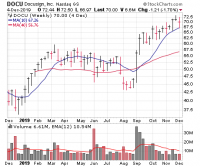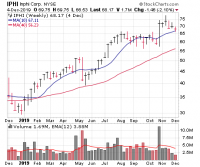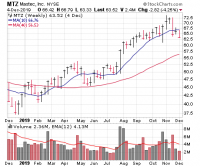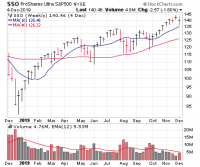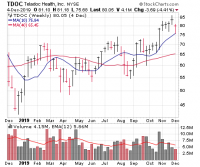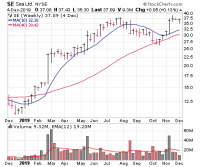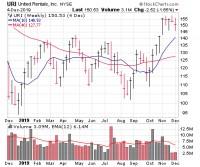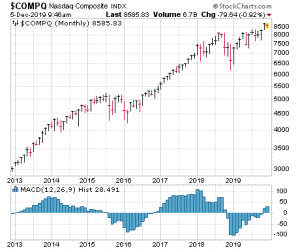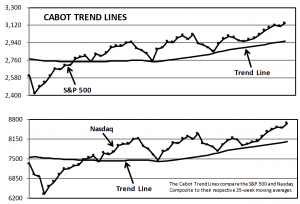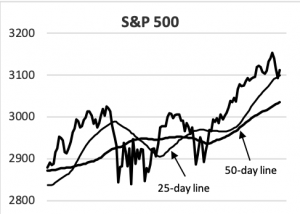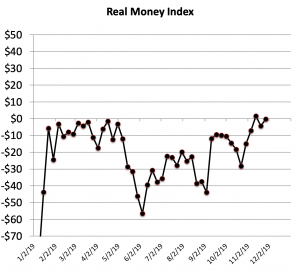The market has finally begun to consolidate after a heady eight-week run in the major indexes and leading stocks. It’s never fun to see things retrench, and we do think the next couple of weeks (very roughly speaking) could see more choppy, tedious trading. But our focus remains on the intermediate- and longer-term picture, and on that front, the evidence remains bullish, so we remain heavily invested.
The Model Portfolio has been steadily putting money to work, including filling out two positions last week. We now have eight stocks and a cash position of around 14%.
In tonight’s issue, we give our latest thoughts on all our positions and write about yet another unique, longer-term bullish occurrence that bodes well going forward.
Cabot Growth Investor 1434
[premium_html_toc post_id="191966"]
A Normal Breather
As the market pushed sharply higher following its early-October low (10% or so in the S&P 500, 12%-plus in the Nasdaq), rising seven out of eight weeks, the worries of the world (trade wars, slowing economic growth, even impeachment) were slowly forgotten. As we wrote in the last issue, that two-month advance and the lack of immediate worry raised the odds of some passing showers for the market in the near-term.
And that rainy day finally arrived this week big as investors returned from the Thanksgiving weekend. The reason given for the sudden selling was some tough talk regarding the U.S.-China trade spat, along with the never-ending uncertainty surrounding the economy. But, really, we think it’s simply a matter of a strong market undergoing a normal breather.
Of course, given the wild, news-driven moves of 2019, we’re keeping our antennae up. Maybe if the trade war really heats up again (more tariffs, etc.) or some other unexpected event occurs, the market could change character. And, looking at the next week or two, we do think the odds favor further volatility as stocks consolidate their recent gains and bring some “overbought” measures back down to Earth.
But on an intermediate- to longer-term basis, the vast majority of evidence remains bullish—the major indexes and nearly all leaders are still in solid uptrends, and even most secondary measures (sentiment, breadth, etc.) look fine. We’re even seeing further unique, big-picture bullish evidence, too, which bodes well for the months ahead. (See more in our writeup later in this issue.) Until proven otherwise, then, we continue to think the next big move will be up and advise remaining in a heavily invested position.
That doesn’t necessarily mean you should stand still, though. As time passes, part of an investor’s job is to kick out stocks that aren’t performing up to snuff and put money to work in what look like true market leaders; remember, the goal isn’t to be right on every pick, but to make money overall, and you do that by emphasizing the positive.
On that front, we think we own a few real leaders of this advance, and if any offer up good-looking entry points we could average up. Meanwhile, we’re keeping a close eye on a couple of laggards in case they give up the ghost. Tonight, though, we’re content to stand pat and see how the stocks we own and are watching progress as the market shakes out some weak hands.
What to Do Now
Remain bullish. Our only moves of the past couple of weeks was to fill out our positions in both Dexcom (DXCM) and Qorvo (QRVO). That leaves us holding eight stocks and around 14% in cash, which we think is a prudent stance right here.
Model Portfolio Update
Nobody enjoys market pullbacks when they’re heavily invested, but one of the good aspects of these retreats is that they can provide a clue to what stocks big investors are really pining after. You always want to use market and stock action as a feedback mechanism.
In the Model Portfolio, we’re happy that most of our names are acting well; as we wrote above, we think we own at least a couple of true leaders, though we’re always open to new evidence as it emerges. On the flip side, MasTec continues to struggle, but we’re OK giving it a touch more rope, while Inphi has done nothing wrong but is mostly meandering.
As always, we’re flexible and are open to adjusting our stance and positions, either selling laggards or buying new names at good entry points. Tonight, though, we’re standing pat with our collection of stocks and modest (14%) cash position.
Current Recommendations
Dexcom (DXCM 227)—Medical stocks remain one of (if not the) go-to areas for growth stock investors, and we think Dexcom has all the makings of a liquid leader, with a top (most say the best) product in a quickly expanding market; rapid, estimate-beating sales and earnings growth during the past few quarters; and a chart that shows a major blastoff in November after 14 months of no progress. Shares took a hit Monday after one of the G6’s apps (dubbed Follow) that allows parents to remotely track their kids’ glucose levels went down because of a server issue. That’s not good optics, but it’s not likely to affect things down the road—the firm will surely take steps to prevent any prolonged outage again and the stock quickly recovered. Further wobbles are always possible after the stock’s straight-up run, but we filled out our stake last week (adding another half-sized position) and are holding on tightly to our shares. If you don’t own any, you could start small here or on further weakness. BUY.
DocuSign (DOCU 70)—DOCU has been on-again, off-again of late, surging to new price highs before pulling back with many names this week, partly due to some poor cloud software-related reports (WDAY and CRM). Still, the stock’s intermediate-term future will likely be determined by its own quarterly report tonight: Analysts are looking for revenues of $240 million (up 38%) and earnings of three cents per share, though billings growth and the outlook will be just as important. From a student-of-the-market perspective, it’s rare for a growth stock with top characteristics (story, growth numbers, etc.) that has recently had a coming out party (as DOCU did in September) to completely give up the ghost on the next report; if anything, the next quarter often brings a positive reaction. But earnings reports are always a roll of the dice, so though we have high hopes that DocuSign has plenty of upside ahead, we’ll take it as it comes. A dive below 60 or thereabouts would be bearish, telling us big investors have moved on, but right now shares are in a good position to continue their advance, especially if the report pleases. We’ll stay on Buy but will update that if need be after the report. BUY.
Inphi (IPHI 68)—IPHI has been sagging during the past couple of weeks with the broad semiconductor group, but it hasn’t done anything wrong—shares have thus far found support near the top of their August-October basing zone and north of their 50-day line. Encouragingly, the fundamental breadcrumbs continue to improve: One analyst highlighted Inphi’s new, faster digital signal processor platform (dubbed Canopus) that will be used in next-generation data center interconnect, long haul, metro and other applications; it should expand its addressable market to other huge data center players and even to networking OEMs like Arista and Juniper. Canopus isn’t going to boost business right away but should help as the need for speed increases. Back to the stock, a break of the 65 to 66 area would have us going to Hold, with a deeper plunge telling us that the stock probably isn’t a real leader of this advance. But given the story and still-healthy chart, we continue to think the next big move is up. We’re fine buying some here. BUY.
MasTec (MTZ 63)—MTZ remains the black sheep of our current crop of stocks, as it’s been unable to find lasting support since its sharp decline two weeks ago. There’s been no new news from the company following the financial loan to two of its biggest shareholders, but most signs point toward continued good business activity going forward. We’re OK giving the stock a smidge more room, but we’re also seeing many cyclical-oriented stocks that are acting well (lots are tightening up after multi-week advances), so if MTZ doesn’t shape up right quick, we could replace it with a stronger name, be it cyclical (United Rentals, written about in Other Stocks of Interest, is one candidate) or growth-oriented. Right now, we’re hanging on, but we’ll be watching closely. HOLD.
ProShares Ultra S&P 500 Fund (SSO 141)—After running from a low of 118 in early October to a high of 144 last week, the market and SSO have finally succumbed to some profit taking, which wasn’t wholly unexpected. As we wrote at the beginning of this issue, we actually see the odds favoring choppier trading conditions in the near-term, with ups, downs and (likely) news- and rumor-driven moves, which will allow the market to consolidate its recent gains. But our trend-following indicators (Trend Lines and Tides) are still clearly positive, and as we write later in this issue, more unique, longer-term bullish action is occurring, which bodes well when looking a few months down the road. If you own some, hang on, and if not, we’re OK starting a position here or on dips. BUY.
Qorvo (QRVO 106)—QRVO hasn’t done much during the past few weeks, but we think it’s playing possum—the stock has traded relatively tightly since its post-earnings moonshot (that’s a positive, telling us no selling has come into the stock), and this week’s dip found support near the rising 25-day line, which is completely normal and led to a nice snapback. As always, we’re open to anything; if the trade war reignites in a big way, for instance, it’s possible many chip stocks will falter. (China will be by far the largest market for 5G smartphones.) But we think it’s far more likely that Qorvo is a new leading glamour name, with the 5G smartphone boom likely to kick into high gear next year (many see 225 to 250 million 5G smartphones sold next year; Qorvo thinks 300 million will be the number) and grow from there. Long story short, we’re optimistic. We filled out our position (buying another half-sized stake) last week and are holding on tightly. If you’re not yet in, feel free to hop onboard here or on any wobbles. BUY.
Teladoc (TDOC 79)—The combination of the market pullback, non-inspiring analyst commentary (one reiterated a hold rating) and TDOC’s own volatility caused the stock to come under pressure. But like many names, we’re betting this pullback will prove buyable—before this week, shares had not just broken out on the upside and rallied nicely, but also advanced nine weeks in a row and 13 of 14 weeks. Such persistent buying rarely goes away overnight, so while the next couple of weeks could be choppy and tedious, we think the buyers are still in control. Fundamentally, the firm added personalized nutrition counseling to its telehealth offerings this week. And, even better, the firm talked bullishly at an investor conference yesterday; Teladoc said it’s enjoyed a bump in membership from a variety of its big health plan clients outside of United Health (millions new from Centene, for instance, and Aetna is now offering it to many members), and sees plenty of opportunity in “activating” those newer members to drive utilization (which, in turn, drives per-visit fee revenue higher). Indeed, management said that utilization rates of existing groups from one year to the next are increasing at a 30% to 40% rate! Back to the stock, a dip below its rising 50-day line (now near 74) would be a yellow flag, but we continue to think the path of least resistance is up. BUY.
Vertex Pharmaceuticals (VRTX 223)—As opposed to November, when a bevy of clinical updates, submissions and approvals were released, Vertex has been quiet on the news front in recent weeks. But that hasn’t stopped the stock from chugging higher without pausing for breath! Similar to DXCM, we view VRTX has a liquid leader of the medical sector--it’s not likely to go bananas, but it certainly has the look and feel of a name that, after a couple of years in the wilderness, institutional investors are piling into because of the rapid and reliable growth coming up over the next couple of years at least. As with most names that have had a big run, some sort of pullback, rest or shakeout is possible, but the odds strongly favor the first retreat offering a solid entry point—frankly, we’d like to average up if the opportunity presents itself. As for the here and now, we’ll stay on Buy, but consider starting with a smaller-than-normal position if you don’t own any. BUY.
Watch List
- Axon Enterprise (AAXN 73): AAXN has calmed down over the past week after a big post-earnings run to its old highs. Another few days of calm action would be constructive.
- Carvana (CVNA 88): CVNA has bucked us off its saddle a couple of times this year (both half positions), but we might give it one more shot. The story is as good as ever, and after a solid breakout, shares are now pulling back.
- Peloton (PTON 31): PTON accelerated to new highs last week, though it’s pulled back sharply this week. More important to us, the stock remains very wild; we’d like to see it calm down a bit to tell us the weak hands are out.
- Sea Ltd. (SE 38): Sea could be the next big e-commerce firm in the world as it expands in southeast Asia. The stock is set up nicely after a bullish earnings reaction three weeks ago.
- United Rentals (URI 153): If MasTec can’t get out of its own way, we may still want exposure to cyclical areas, and URI looks like one of the better ones out there.
Other Stocks of Interest
InMode (INMD 44)—InMode is a recent IPO that’s off to a hot start, and while the stock’s volatility is extreme, we think the upside potential is huge if things go right. The company, which is based in Israel, plays in the aesthetic industry, which isn’t our favorite area; we’ve seen quite a few firms in that sector blow up during the past decade or two. But InMode looks like it has something special: For patients, its various radio frequency-based platforms can “remodel” (ahem) fatty tissue with little or no incisions, no general anesthesia (most procedures can actually be done on an outpatient basis), can simultaneously kill fat and tighten skin and can also permanently get rid of unwanted hair; for surgeons, the company’s wares typically cost less and take up less space than competing products. (All of the benefits are backed up by a few dozen clinical studies and the products have received approval from many agencies around the world, so it’s not just a sales pitch.) Basically, InMode is targeting those who want more than just aesthetic laser treatments but without the downsides (scars, downtime, anesthesia) of plastic surgery, and so far it’s been a smashing success—sales growth is accelerating (45%, 46%, 55% and 57% during the past four quarters), while the firm is solidly profitable (earnings up 77% in Q3) and, while growth is expected to slow some next year, we think that’s probably conservative given how the firm has trashed estimates recently. As for the stock, it broke out of a brief IPO base in late October and went vertical before a very sharp retreat two weeks ago, and since then it’s been all over the map. But INMD hasn’t broken down, and if it can keep its head above support in the upper 30s going forward, we believe its outstanding story can attract more buyers. It’s worth watching.
Sea Ltd. (SE 38)—Sea Limited isn’t known to most investors, but it’s been a leading glamour name for much of this year and, after a bullish reaction to Q3 earnings, looks ready to resume its advance. Sea is one of a couple of new-age e-commerce outfits in southeast Asia, making its hay in Indonesia, Taiwan, Vietnam, Thailand, the Philippines, Malaysia and Singapore. The firm has both the largest digital entertainment platform and the largest e-commerce operation in the region: On the digital entertainment side, Sea operates the most popular online game platform (dubbed Garena) that includes some hit offerings (its Free Fire game is one of the biggest revenue producing games in the world) as well as leading e-sports functions (where people watch others play competitive video games, believe it or not), and growth has been rapid (up 212% in Q3, though that’s expected to slow in 2020). On the e-commerce side, which has even more long-term potential, the firm’s Shopee brand is a hit (fifth most downloaded shopping app worldwide!), with sales up a mind-boggling 261% in Q3 thanks to booming transaction-based fees (gross merchandise volume up 70% from a year ago; items ordered up 103%) and advertising revenue. Given that e-commerce in Sea’s core markets is expected to quadruple over the next few years, many investors are starting to think this company is an emerging blue chip in the e-commerce field. Earnings remain deep in the red, but the writing is on the wall here, with Sea having a clear path to becoming many times the size it is today. As for the stock, it staged a powerful breakout in February and enjoyed a great five-month run before base-building for three months. The recent earnings reaction was fantastic, and now the stock has calmed down near its highs despite a big ($1 billion) dilutive convertible offering last month. We like the look of it and a strong breakout would likely be buyable.
United Rentals (URI 153)—United Rentals is straight out of central casting when it comes to cyclical stocks; the company is the #1 equipment rental company in North America (nearly twice the market share of its next largest competitor), with nearly 1,200 branches in North America and Canada and a fleet valued at $15 billion. There is a longer-term growth aspect here (a growing number of customers prefer to rent vs. buy heavy equipment to cut capital outlays and maintenance costs), and the company has done a nice job over the years wringing out the waste from its operation (free cash flow is buoyant at $1.5 billion this year; the stock trades at just 7.5 times that figure) and expanding into specialty services like trench safety, HVAC and more (specialty is now more than 20% of revenues). But at day’s end, the stock moves very much with perceptions of the economy, especially with regard to non-residential construction, oil & gas facilities, infrastructure and more. And at this point it appears perception may have turned a corner; thanks partly to acquisitions, sales and earnings growth in recent quarters has pushed steadily higher and generally topped estimates, and the Q3 report in mid October (sales up 18%, earnings up 26%) helped the stock kick off a steady advance. Analysts see earnings up just 6% in 2020, but (a) as we mentioned earlier, the valuation is already in the basement, and (b) those estimates will likely prove low if the U.S. economy gains steam, which the market seems to be discounting. As for the stock, URI peaked in early 2018 at 190 and was hanging out in the 110 area in early October of this year before racing back to the mid 150s a couple of weeks ago. Now shares are consolidating nicely.
More Longer-Term Bullish Evidence Emerges
One of the satisfying parts about getting back into the market very early this year (besides making money) was that it happened not because of a hunch or news items, but because of our system; back in January (and again in February), certain blastoff indicators flashed green, which was a very strong sign that the late-2018 disaster had ended and a new bull trend was emerging.In fact, those blastoff indicators—as well as our Cabot Trend Lines, which turned positive in February and have remained so ever since—were the big reason why, despite a ton of negative headlines and (in the fall) some ugly breakdowns from growth stocks, we thought the next big move was going to be up. And that’s proven correct during the past couple of months.
You can always find bullish or bearish evidence out there, but what’s impressive is that we’re still seeing some rare market signals that tend to happen near the beginning of major moves! We’ve written about one of these before; at the end of June, both stock and bond prices had rallied at least 10% during the prior six months. That had happened fewer than a dozen times since 1970, and the S&P 500 advanced nearly 20% on average a year later.
Interestingly, another longer-term signal flashed a month later, and it involves MACD, which many investors use as a shorter-term momentum indicator for individual stocks. But this signal comes from a monthly MACD that indicates the S&P’s (very) long-term momentum—at the end of July, this measure turned “positive” again after a spell in negative territory (caused by last year’s decline). That was just the 11th “buy signal” (if you want to call it that) since 1980, and in the prior instances, the S&P rose a year later every time by an average of 16.5%.
Of course, that signal occurred a few months ago; since then, the S&P 500 is up 4.5%, and this rare signal argues for much more during the next six to eight months, too. But what’s even more encouraging is that other indexes have recently followed suit—just last week (end of November), the monthly MACD turned positive for the Nasdaq (shown here), the NYSE Composite and the Dow Industrials!
As we always say, there are no perfect indicators out there, and even these sorts of occurrences are more background measures than signals to take direct action on. But as 2019 hits the home stretch, many of these big picture measures tell us the bull market has plenty of upside left.
Initial Pullbacks are Usually Buyable
Investing in the market is about getting an edge, and a lot of that comes from market timing and picking stocks that big investors are becoming increasingly bullish on. But good entry points can also help a lot, too, and one of the higher-odds (not perfect, but solid risk/reward) times to buy is during a stock’s first pullback after a breakout and persistent, multi-week advance.
The idea is simple (most good investing ideas are): First, there’s usually a long consolidation that wears out the weak hands. Second, the breakout and run-up are caused by institutional investors … but they almost never are able to get all the shares they want. Thus, when some bad news hits or the market pulls in for a bit, there are usually many big buyers waiting to snap up shares.
Obviously, not all pullbacks are alike, but there are usually two general forms that are worth looking for, especially if the recent profit taking continues. The first isn’t much of a pullback at all, but usually two to four weeks of relatively tight trading, which often is a sign people are buying in a certain price zone. United Rentals (URI), written about earlier in this issue, is one example.
The other is a sharp pullback over a few days (which is actually fairly typical action in a bull market) that serves to knock out the late buyers and attract some eager shorts. We haven’t seen too many of these yet, but it’s not hard to imagine—a pullback of 10 or 12 points in a name like Vertex (VRTX), for example, would likely offer a great time to get in (and possibly a time to add a few more shares if you already own it).
We’re not going to get into the minutiae of evaluating pullbacks here, but the point is that after strong, persistent advances in many stocks and indexes, any shakeout-type action should result in an opportunity to put a little more money to work.
Cabot Market Timing Indicators
After a strong two-month advance, stocks are finally giving up some ground, and another week or two of digestion wouldn’t be abnormal—now’s probably not the time to pile into a half-dozen stocks. But we’re focusing mostly on the bigger picture, which remains bullish and tells us to remain heavily invested.
Cabot Trend Lines: Bullish
As they have been since February of this year, our Cabot Trend Lines remain firmly in positive territory, with the S&P 500 (by 6.2%) and Nasdaq (by 7.4%) well above their respective 35-week moving averages. That keeps the longer-term trend pointed up and, along with other positive big-picture action (like the MACD study above), tells us the bull market likely has much farther to run.
Cabot Tides: Bullish
Our Cabot Tides are also still solidly positive, telling us the intermediate-term trend is pointed up. Despite some indigestion this week, all five indexes we track (including the S&P 500, daily chart shown here) are hovering above their lower (50-day) rising moving averages, including even the lagging small- and mid-cap indexes. Further dips are obviously possible, but the odds continue to favor higher prices ahead.
Cabot Real Money Index: Neutral
Our Real Money Index remains in neutral territory as basically zero dollars (net-net) have flowed into or out of equity funds and ETFs during the past five weeks. Officially, then, there’s no short-term edge here from a money flow perspective—though we still take it as a positive that investors have been so hesitant to jump into the market despite the steep uptrend of the past two months, a sign that plenty of buying power remains on the sideline.
Charts courtesy of StockCharts.com
The next Cabot Growth Investor issue will be published on December 19, 2019.
Cabot Wealth Network
Publishing independent investment advice since 1970.
CEO & Chief Investment Strategist: Timothy Lutts
President & Publisher: Ed Coburn
176 North Street, PO Box 2049, Salem, MA 01970 USA
800-326-8826 | support@cabotwealth.com | CabotWealth.com
Copyright © 2019. All rights reserved. Copying or electronic transmission of this information is a violation of copyright law. For the protection of our subscribers, copyright violations will result in immediate termination of all subscriptions without refund. No Conflicts: Cabot Wealth Network exists to serve you, our readers. We derive 100% of our revenue, or close to it, from selling subscriptions to its publications. Neither Cabot Wealth Network nor our employees are compensated in any way by the companies whose stocks we recommend or providers of associated financial services. Disclaimer: Sources of information are believed to be reliable but they are not guaranteed to be complete or error-free. Recommendations, opinions or suggestions are given with the understanding that subscribers acting on information assume all risks involved. Buy/Sell Recommendations: All recommendations are made in regular issues or email alerts or updates and posted on the private subscriber web page. Performance: The performance of this portfolio is determined using the midpoint of the high and low on the day following the recommendation. Cabot’s policy is to sell any stock that shows a loss of 20% in a bull market or 15% in a bear market from the original purchase price, calculated using the current closing price. Subscribers should apply loss limits based on their own personal purchase prices.



